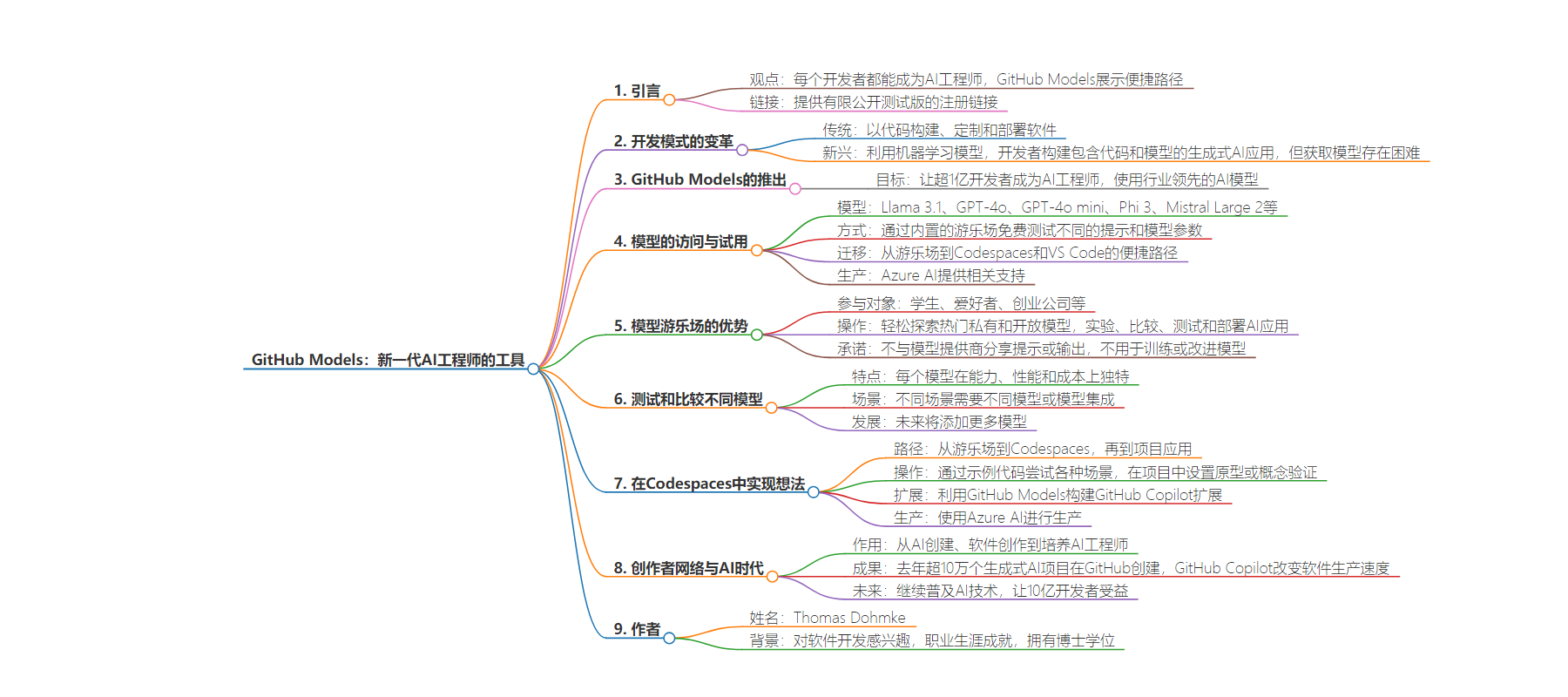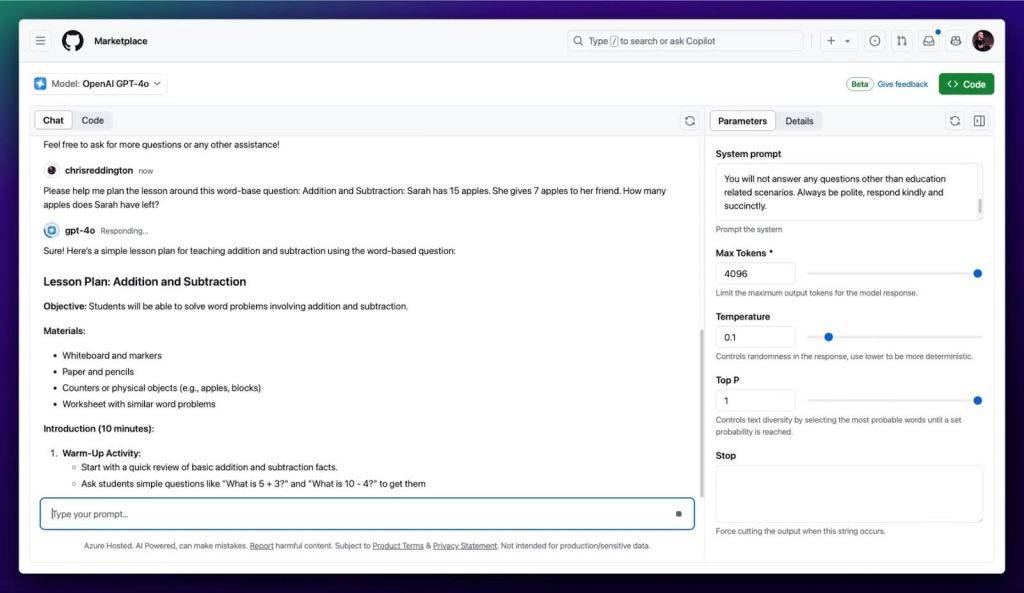包阅导读总结
1. 关键词:GitHub Models、AI 工程师、开发工具、模型测试、生产部署
2. 总结:GitHub 推出 GitHub Models,使开发者能借助多种领先的 AI 模型成为 AI 工程师,提供从测试到生产部署的便利,包括模型游乐场、Codespaces 及 Azure AI 支持,旨在加速 AI 应用开发。
3. 主要内容:
– GitHub Models 发布
– 目标是让超 1 亿开发者成为 AI 工程师
– 支持多种模型,如 Llama 3.1、GPT-4o 等
– 模型游乐场
– 可免费测试不同模型和参数
– 不与模型提供者共享提示或输出
– 开发流程
– 在 Codespaces 中进行实验
– 在项目中应用,可在 GitHub Actions 中运行提示评估
– 可通过 Azure AI 进行生产部署
– 对开发者的影响
– 降低开发门槛,加速创新
– 助力开源协作和软件创作
– 促进 AI 工程师的崛起
思维导图:
文章地址:https://github.blog/news-insights/product-news/introducing-github-models/
文章来源:github.blog
作者:Thomas Dohmke
发布时间:2024/8/1 15:58
语言:英文
总字数:972字
预计阅读时间:4分钟
评分:91分
标签:AI 开发,GitHub 模型,机器学习,AI 模型实验平台,Codespaces
以下为原文内容
本内容来源于用户推荐转载,旨在分享知识与观点,如有侵权请联系删除 联系邮箱 media@ilingban.com
| We believe every developer can be an AI engineer with the right tools and training. From playground to coding with the model in Codespaces to production deployment via Azure, GitHub Models shows you how simple it can be. Sign up for the limited public beta HERE. |
From the early days of the home computer, the dominant mode of creation for developers has long been building, customizing, and deploying software with code. Today, in the age of AI, a secondary and equally important mode of creation is rapidly emerging: the ability to leverage machine learning models. Increasingly, developers are building generative AI applications where the full stack contains backend and frontend code plus one or more models. But a vast segment of developers still lack easy access to open and closed models. This changes today.
We are launching GitHub Models, enabling our more than 100 million developers to become AI engineers and build with industry-leading AI models.
From Llama 3.1, to GPT-4o and GPT-4o mini, to Phi 3 or Mistral Large 2, you can access each model via a built-in playground that lets you test different prompts and model parameters, for free, right in GitHub. And if you like what you’re seeing on the playground, we’ve created a glide path to bring the models to your developer environment in Codespaces and VS Code. And once you are ready to go to production, Azure AI offers built-in responsible AI, enterprise-grade security & data privacy, and global availability, with provisioned throughput and availability in over 25 Azure regions for some models. It’s never been easier to develop and run your AI application.
VIDEO
The joy begins in the model playground on GitHub
For most of us, learning to be a developer didn’t happen on a linear path in the classroom. It took practicing, playing around, and learning through experimentation. The same is true today for AI models. In the new interactive model playground, students, hobbyists, startups, and more can explore the most popular private and open models from Meta, Mistral, Azure OpenAI Service, Microsoft, and others with just a few clicks and keystrokes. Experiment, compare, test, and deploy AI applications right where you manage your source code.
In alignment with GitHub and Microsoft’s continued commitment to privacy and security, no prompts or outputs in GitHub Models will be shared with model providers, nor used to train or improve the models.

| Professor David J. Malan will be putting GitHub Models to the test in Harvard’s CS50 this fall, to enable students to experiment with AI all the more easily. |
Test and compare different models
Every piece of software is unique. And likewise, every model is unique in its capabilities, performance, and cost. Mistral offers low latency, while GPT-4o is excellent at building multimodal applications that might demand audio, vision, and text in real time. Some advanced scenarios might require the integration of different modes, such as an embeddings model for Retrieval Augmented Generation (RAG).
With the suite of models, developers will have all the options they need to stay in the flow, experiment more, and learn faster than ever before. And this is just the first wave. In the months ahead, as we approach the general availability of GitHub Models, we will continue to add more language, vision, and other models to our platform.

Spin up Codespaces to bring your ideas to life
The fun doesn’t just stay in the playground. With the power of Codespaces, we’ve created a zero-friction path for you to experiment with the model inference code before dropping it into your own project. With sample code for a variety of languages and frameworks of all types ready to go, you can try out various scenarios without ever hitting “works on my machine” problems.
VIDEO
Then, once you’re ready, it’s a breeze to get things running in your project. Use the knowledge you’ve gained from the playground and Codespaces to set up a prototype or proof-of-concept within your own applications. Run prompt evals in GitHub Actions with a series of JSON files that you just pipe in the GitHub Models command within the GitHub CLI. Or you can leverage GitHub Models to build a GitHub Copilot Extension, extending GitHub’s platform ecosystem for every stage of software development. And finally, go to production with Azure AI by replacing your GitHub personal access token with an Azure subscription and credential.
As an AI startup founder and open source maintainer, GitHub Models enables my team to access and experiment with various LLMs in one place. This streamlines our development and lowers the entry barrier for building AI apps.
The creator network for the age of AI
From the creation of AI through open source collaboration, to the creation of software with the power of AI, to enabling the rise of the AI engineer with GitHub Models – GitHub is the creator network for the age of AI.
The path to artificial general intelligence (AGI) will not be built without the source code and collaboration of the interconnected community on GitHub. Just in the last year, more than 100K generative AI projects were created on GitHub.
GitHub Copilot is foundationally changing the speed of software production, already writing nearly 50% of code in files where it’s enabled. With GitHub Copilot Workspace, we envision a world where millions of novice, hobbyist, and professional developers alike can code with entirely human language.
And now with GitHub Models, more than 100 million developers can access and experiment with new AI models where they already manage their source code, issues, pull requests, workflows, and repositories – directly on GitHub.
In the years ahead, we will continue to democratize access to AI technologies to generate a groundswell of one billion developers. By doing so, we will enable 10% of the world’s population to build and advance breakthroughs that will accelerate human progress for all.
Today, we begin the limited public beta for GitHub Models. Sign up now. We can’t wait to see what you will build from here.
Written by
Fascinated by software development since his childhood in Germany, Thomas Dohmke has built a career building tools developers love and accelerating innovations that are changing software development. Currently, Thomas is Chief Executive Officer of GitHub, where he has overseen the launch of the world’s first at-scale AI developer tool, GitHub Copilot — and now, GitHub Copilot X. Before his time at GitHub, Thomas previously co-founded HockeyApp and led the company as CEO through its acquisition by Microsoft in 2014, and holds a PhD in mechanical engineering from University of Glasgow, UK.
